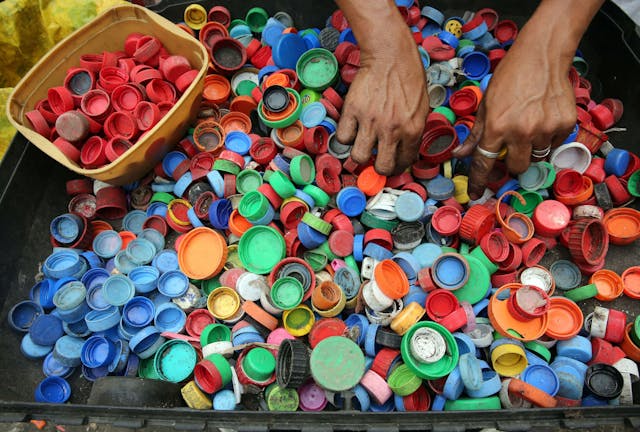
How many types of plastic are there? There are many different types of plastic, but they have been grouped into 7 different types of plastic. They are PET, HDPE, PVC, LDPE, PP, PS, and other. You can tell which ones they are because of their Resin Identification Code, which has a triangle made of arrows and the numbers 1 to 7 on it.
Number 1 is PET. PET stands for PolyEthylene Terephthalate. It is one of the most common plastics used today and is used for plastic bottles among many other uses. PET bottles only make up for about 30% of the use of PET. The majority of PET is used in fiber form to make clothes and materials. The polyester that many of our clothes are made out of is PET. Polyester is very strong, durable, insulting, quick drying, easy to wash, and it holds its shape very well. It is very good at keeping oxygen out, which makes the drinks it holds last much longer. It takes 1.9 kg of oil to make 1 kg of PET.
Number 2 is HDPE, which stands for High-Density Polyethylene. It has longer polymers than PET, so it is much stronger. It is very resistant to chemicals, acids, and alcohol, which makes it perfect to use as a container. HDPE is used in reusable shopping bags, containers, shampoo bottles, detergent containers, and harder, more rigid structures like playground equipment, and recycling bins. HDPE is strong and can be heated to 120℃ without losing its shape. Of all the plastics, HDPE is the easiest to recycle. I’m not sure if the fact that the easiest plastic to recycle being used to make recycling bins is ironic or not. It is easier to recycle because it has longer polymers. Each time a plastic is recycled, the polymer shrinks, so the longer the polymer, the easier it is to recycle. It takes 1.75 kg of oil to make 1 kg of HDPE.
Number 3 is PVC, which stands for PolyVinyl Chloride. PVC can be made into rigid or flexible forms. When it is rigid it is very strong and durable. It has become a very common building material and you’ll find it in plumbing pipes, some windows, doors, and many of the structures in a building. It is rapidly becoming the most popular building material. In its flexible form it is used to make tubes that bend, things like shower curtains, and cling film. If you have a pair of rubber boots, they are probably made of PVC. To make 1 kg of PVC, you need 0.43 kg of oil and 0.57 kg of salt. PVC is the least recycled plastic.
Number 4 is LDPE, which stands for Low Density Polyethylene. It is much thinner and more flexible than its high-density version. It is used in throw away shopping bags, plastic wrapping, the rings that hold drinks together, and things like ketchup bottles. It is soft and stretches when you try to tear it. You need 2 kg of oil to make 1 kg of LDPE. This is the main reason why we shouldn’t use throw away plastic bags and packaging.
Number 5 is PP, which is PolyPropylene. It is very strong and durable, flexible, and resistant to heat. You’ll find PP in your Tupperware boxes, food packaging containers, bottle caps, yoghurt pots, car bumpers, syringes, ropes, plastic garden furniture, and a myriad of other places. It takes 1.75 kg of oil to make 1 kg of PP. It is very light, very flexible, very resistant to heat, and resistant to fatigue, which makes it incredibly popular. Use of PP is going up year on year.
Number 6 is PS, which stands for PolyStyrene. You probably know what this is used for without me having to tell you. It can be made into solid shapes or air filled foam shapes. You’ll find it in cups, insulation, packaging, and disposable containers. Polystyrene requires about 2 kg of oil to make 1 kg. It is the worst plastic we have because it leaches harmful chemicals when heated, can not be recycled, is blown away easily, floats on water, uses a lot of oil, and is incredibly cheap to make.
Number 7 is other, and all of the plastics that don’t fit into the other 6 categories go here. Other contains plastics like nylon, fiberglass, acrylic, and PLA. Your LEGO bricks, computer keyboard, CDs, and 3D printed stuff all come from other. And this is what I learned today.
Try these next:
Sources
https://www.plasticsforchange.org/blog/different-types-of-plastic
https://en.wikipedia.org/wiki/Plastic
https://en.wikipedia.org/wiki/Polyethylene_terephthalate
https://en.wikipedia.org/wiki/Resin_identification_code
Photo by Krizjohn Rosales: https://www.pexels.com/photo/person-hands-on-assorted-color-plastic-lid-lot-761297/
